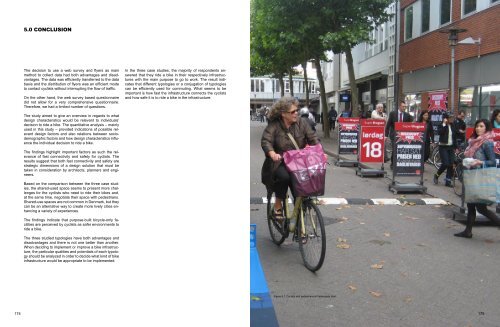Aalborg Universitet Bike Infrastructures Report Silva, Victor ... - VBN
Aalborg Universitet Bike Infrastructures Report Silva, Victor ... - VBN
Aalborg Universitet Bike Infrastructures Report Silva, Victor ... - VBN
You also want an ePaper? Increase the reach of your titles
YUMPU automatically turns print PDFs into web optimized ePapers that Google loves.
5.0 CONCLUSION<br />
The decision to use a web survey and flyers as main<br />
method to collect data had both advantages and disadvantages.<br />
The data was efficiently transferred to the data<br />
basis and the distribution of flyers was an efficient mode<br />
to contact cyclists without interrupting the flow of traffic.<br />
On the other hand, the web survey based questionnaire<br />
did not allow for a very comprehensive questionnaire.<br />
Therefore, we had a limited number of questions.<br />
In the three case studies, the majority of respondents answered<br />
that they ride a bike in their respectively infrastructures<br />
with the main purpose to go to work. The result indicates<br />
that different typologies or a conjugation of typologies<br />
can be efficiently used for commuting. What seems to be<br />
important is how fast the infrastructure connects the cyclists<br />
and how safe it is to ride a bike in the infrastructure.<br />
The study aimed to give an overview in regards to what<br />
design characteristics would be relevant to individuals’<br />
decision to ride a bike. The quantitative analysis – mainly<br />
used in this study – provided indications of possible relevant<br />
design factors and also relations between sociodemographic<br />
factors and how design characteristics influence<br />
the individual decision to ride a bike.<br />
The findings highlight important factors as such the relevance<br />
of fast connectivity and safety for cyclists. The<br />
results suggest that both fast connectivity and safety are<br />
strategic dimensions of a design solution that must be<br />
taken in consideration by architects, planners and engineers.<br />
Based on the comparison between the three case studies,<br />
the shared-used space seems to present more challenges<br />
for the cyclists who need to ride their bikes and,<br />
at the same time, negotiate their space with pedestrians.<br />
Shared-use spaces are not common in Denmark, but they<br />
can be an alternative way to create more lively cities enhancing<br />
a variety of experiences.<br />
The findings indicate that purpose-built bicycle-only facilities<br />
are perceived by cyclists as safer environments to<br />
ride a bike.<br />
The three studied typologies have both advantages and<br />
disadvantages and there is not one better than another.<br />
When deciding to implement or improve a bike infrastructure,<br />
the particular qualities and potentials of each typology<br />
should be analyzed in order to decide what kind of bike<br />
infrastructure would be appropriate to be implemented.<br />
Figure 5.1: Cyclists and pedestrians at Vestergade Vest.<br />
174 175
















